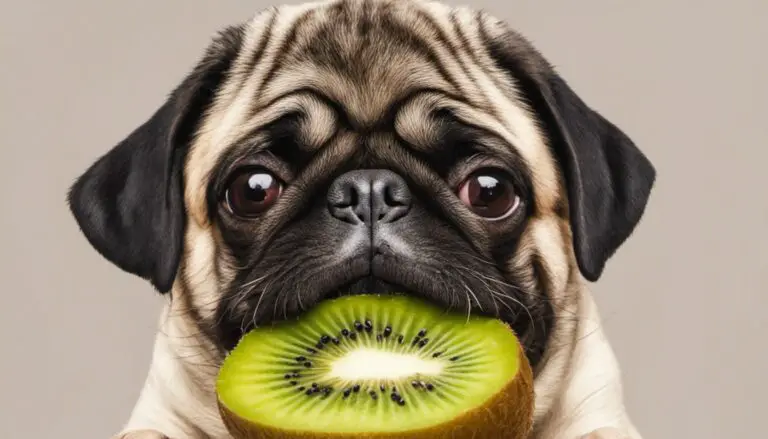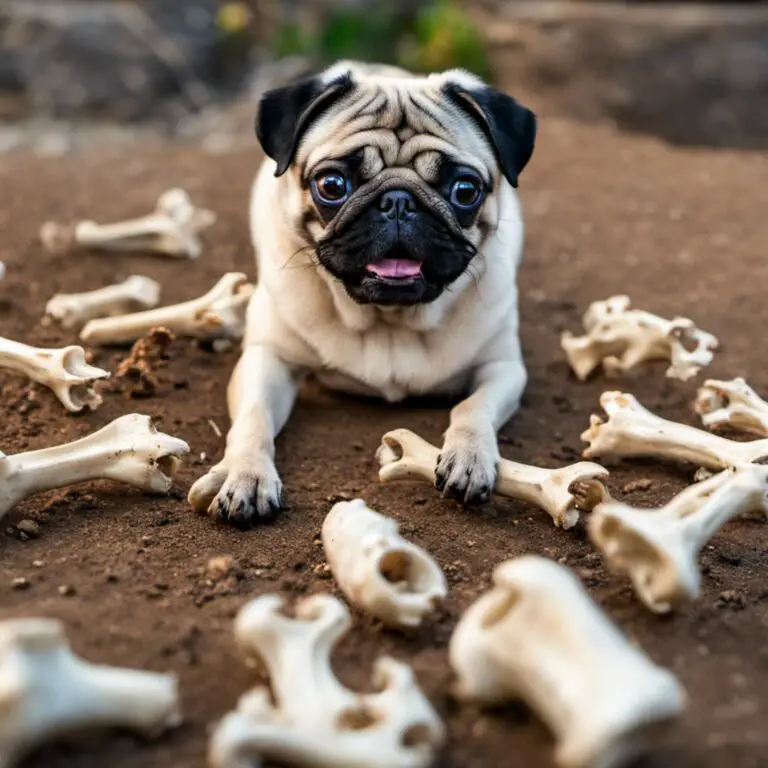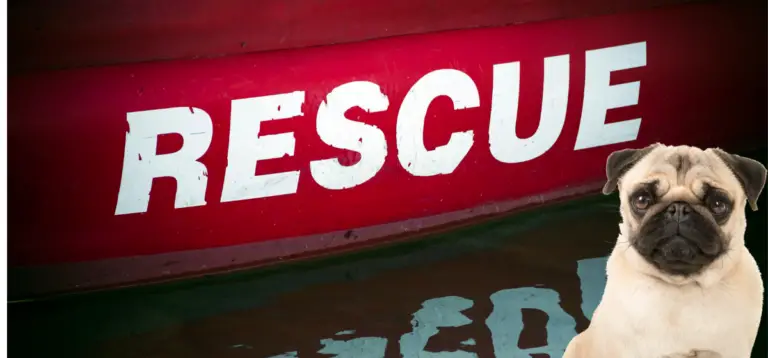Can Pugs Eat Ice Cream? A Vet’s Perspective

As a pug owner, you may find yourself wondering if it’s safe to share some of your favorite treats with your furry friend. One popular question that frequently arises is, Can Pugs Eat Ice Cream? It’s important to be aware of the potential risks and benefits associated with feeding ice cream to your pug.

Ice cream can be a tempting treat for both humans and dogs on a hot summer day. While some dogs may be able to enjoy an occasional lick of plain vanilla or strawberry ice cream in tiny amounts, it’s not something that should become a regular part of their diet source. Feeding your pug ice cream may have negative consequences, as many flavors contain ingredients that can be harmful or even toxic to dogs, such as chocolate and artificial sweeteners source.
Contents
Table of Contents
Pugs and Human Food

As a pug owner, you might wonder if sharing some of your favorite human foods with your furry friend is safe. While certain foods can provide extra nutritional benefits for your pug, others can be harmful or even toxic.
First of all, pugs can enjoy various human foods like beef, chicken, salmon, and tuna. These types of meat are rich in protein and contribute to maintaining your pug’s muscle health. Remember to cook the meat properly and avoid adding seasoning or spices, as some of these might irritate your pug’s stomach.
Get The Free Food Eating Guide That Keeps My Pug Happy and Playful Even at 13 Years Old
100% Beginner Friendly & Lists Real Foods Your Pug Can Actually Eat!

Grains such as bread, corn, rice, and oatmeal can also be included in your pug’s diet. These are great sources of energy and can be easily combined with other foods. Make sure to provide them in moderate amounts and occasionally, as pugs have a tendency to gain weight if they consume high-calorie foods regularly.
Some fruits and vegetables are suitable for your pug too. For example, blackberries can be a healthy snack option, as they are low in calories and high in vitamins, minerals, and antioxidants. Just make sure to avoid processed versions of these foods, like blackberry jam or blackberry-flavored ice cream, as they may contain harmful chemicals.
When it comes to dairy products, you should exercise caution. While some pugs can tolerate small amounts of yogurt or ice cream, others might experience gastrointestinal issues. It’s important to note that some ice cream flavors, like chocolate or those containing xylitol, can be toxic to dogs.
As for treats, pugs can enjoy rawhide, beef bones, or pig ear chews. These can be found in any pet store, and your pug will likely have its favorites. Cheese and small portions of cooked meat can also be used as treats in training sessions.
Be aware that not all human foods are safe for your pug. Foods like avocado, onion, chocolate, macadamia nuts, grapes, and caffeine should be avoided, as they can be toxic to your pet.
In summary, your pug can enjoy a variety of human foods, but always exercise caution and introduce new foods gradually. Keep portions small and maintain a balanced diet to ensure a healthy and happy pug.
Ice Cream and Dogs

Before you decide to give your pug a lick of your ice cream cone, it’s essential to understand whether ice cream is safe for dogs. Dogs have different digestive systems than humans, and certain foods can cause them harm.
Ice cream is made from dairy, which means it contains lactose. Although some dogs can tolerate lactose, many are lactose intolerant and can’t properly digest dairy products. If your pug is lactose intolerant, consuming ice cream may lead to digestive issues such as gas, bloating, diarrhea, or vomiting.
In addition to the dairy content, ice cream is typically high in sugar and fat, which can be harmful to dogs in large amounts. While it might be safe for your pug to have an occasional small lick of plain vanilla or strawberry ice cream, it’s crucial not to make it a regular part of their diet.
Flavors also significantly affect whether your pug can safely consume ice cream. For example, chocolate ice cream is dangerous due to the presence of theobromine, which dogs’ bodies cannot digest. Similarly, sugar-free ice cream that contains artificial sweeteners like xylitol can be toxic to dogs.
In conclusion, while sharing your ice cream with your pug may be tempting, it’s better to resist the urge. Their digestive systems were not designed to handle lactose, excess sugar, or high-fat content in ice cream. Instead, opt for dog-safe treats that cater specifically to their dietary needs, ensuring that your pug remains healthy and happy.
Hazards of Ice Cream

Feeding your pug ice cream might seem like a fun treat, but there are several reasons why it can be harmful to your pet. The high sugar content in ice cream can lead to obesity and other health issues in dogs. Moreover, sugarless ice cream can be dangerous as well since it often contains xylitol, a toxic substance for them. Consuming xylitol can cause vomiting, seizures, and even death in some cases.
Most dogs, including pugs, are lactose intolerant. Feeding them ice cream may result in gastrointestinal discomfort, gas, and upset stomach. Your pug may experience diarrhea, vomiting, or both in severe cases. These symptoms indicate that your dog is unable to digest lactose properly, leading to intestinal distress.
Certain ice cream flavors can pose additional hazards besides sugar and lactose. For example, chocolate contains theobromine and caffeine, both of which are toxic to dogs. Ingestion of these substances can lead to rapid breathing, increased heart rate, and even seizures. To minimize these risks, avoiding feeding your pug any ice cream containing chocolate or caffeine is best.
Finally, regular consumption of ice cream can contribute to other serious health issues in pugs, such as pancreatitis. The high-fat content in ice cream can trigger this painful condition, as dogs’ digestive systems are not equipped to handle such rich foods. If left untreated, Pancreatitis can lead to severe stomach pain, vomiting, and even death.
In conclusion, while ice cream might be a tempting treat for you and your pug to share, it’s best to avoid it altogether. Providing your pug with a healthy diet and dog-safe treats will ensure their well-being and prevent potential complications from exposure to harmful ingredients found in human foods like ice cream.
Sweeteners and Ice Cream

When it comes to feeding your pug ice cream, it’s essential to consider the sweeteners used in the product. The most common sweetener in ice cream is sugar, which is not toxic to dogs but can lead to obesity, dental issues, and diabetes if consumed in large quantities. As a responsible pug owner, you should limit your dog’s intake of sugar-laden treats.
Artificial sweeteners can pose more significant issues for your pug. Many ice creams contain artificial sweeteners to reduce the calorie count. One such sweetener is xylitol, which can be extremely dangerous to dogs. Even small amounts of xylitol can cause rapid insulin release, leading to hypoglycemia (low blood sugar), seizures, liver failure, or even death. Therefore, avoiding ice cream containing xylitol or any other harmful artificial sweetener is crucial.
Honey may be present in some ice cream varieties as a natural sweetener. While honey is safe for dogs in moderation, it is also high in sugar and should not be a regular part of your pug’s diet. If you give your pug a small taste of honey-sweetened ice cream, ensure it doesn’t contain other harmful sweeteners or ingredients.
In conclusion, sugar, artificial sweeteners, xylitol, and honey can all be found in different types of ice cream. As a pug owner, it’s your responsibility to ensure that your dog’s ice cream treat is safe for consumption. Always read the ingredient list carefully and avoid products containing xylitol or other harmful substances. Remember that moderation is key, and sweet treats should be an occasional indulgence for your pug, not a regular part of their diet.
Can Pugs Eat Ice Cream? Watch this
Ingredients in Ice Cream
Ice cream is a delicious treat enjoyed by many, but as a pug owner, it’s essential to understand what it’s made of before sharing it with your furry friend. Typically, ice cream consists of dairy products such as milk and cream. These ingredients might not be ideal for pugs since some dogs, like humans, can be lactose intolerant, making it difficult to digest lactose in dairy.
One of the most common ice cream flavors is vanilla. Vanilla ice cream often contains natural or artificial vanilla flavorings along with sugar to add to its sweetness. However, the high sugar content is not recommended for your pug, as excessive sugar consumption can lead to obesity and other health-related issues.
Some ice cream varieties contain nuts, such as macadamia nuts and walnuts. These nuts can be harmful to your pug. Macadamia nuts, in particular, are highly toxic to dogs and can cause vomiting, muscle tremors, and weakness. Walnuts can also be dangerous for your pet as they may contain a fungus that produces tremorgenic mycotoxins, harmful to a dog’s nervous system.
Another concern in ice cream is the inclusion of artificial sweeteners like xylitol. Xylitol can be very dangerous for dogs, causing rapid insulin release and leading to hypoglycemia (low blood sugar). Symptoms may include vomiting, loss of coordination, and seizures. Avoid feeding ice cream with xylitol or any artificial sweeteners to your pug.
Healthy Alternatives to Ice Cream
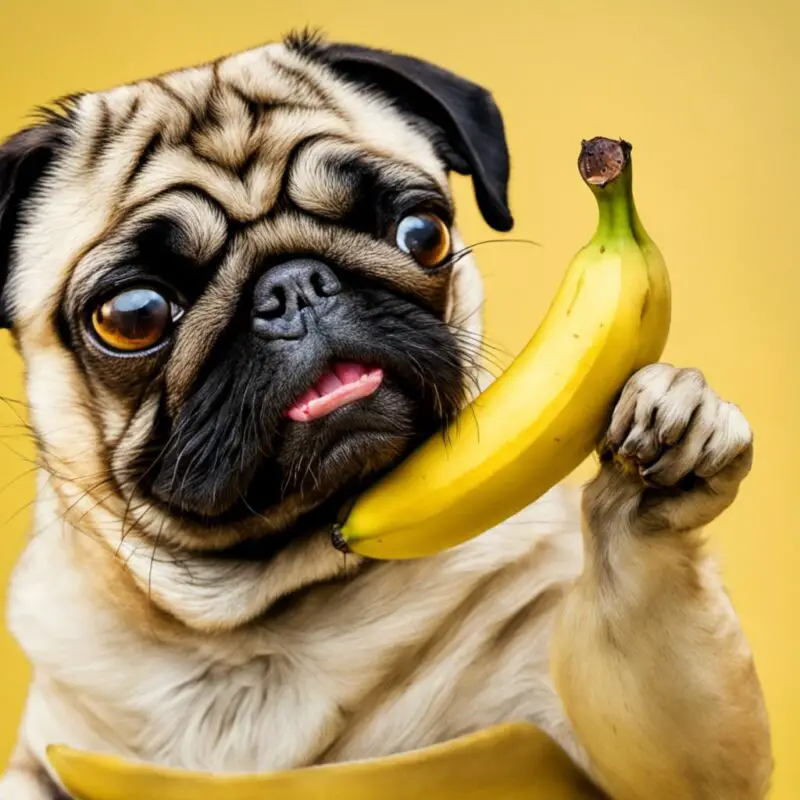
If you’re looking for a cold treat to share with your pug, many healthy options will satisfy their taste buds and keep them safe. One popular choice is dog ice cream or ice cream for dogs. These specially formulated treats are designed with your pet’s health in mind and can be found at many pet stores.
Another excellent alternative to traditional ice cream is plain yogurt. You can even turn it into frozen yogurt by placing it in the freezer for a few hours. This option is high in protein and probiotics, which can benefit your dog’s digestive system.
Fruit-based treats can also be a refreshing and healthy option for your pug. Bananas, mangoes, blueberries, blackberries, pears, and oranges are all safe for dogs to consume and can be frozen or blended into a delicious “nice cream.” Just remember to remove any seeds and peel the fruits before serving them to your pug.
Vegetables can also make for tasty frozen treats! Carrots and pumpkins are not only safe but provide essential nutrients for your pug’s overall well-being. You can puree them and freeze them in ice cube trays for easy portioning and serving.
Here’s a simple recipe for making your own dog-friendly “nice cream”:
- Choose your dog’s favorite fruit or vegetable (e.g., bananas, mango, pumpkin, or carrots)
- Peel and chop the produce into small pieces
- Blend the pieces with a small amount of plain yogurt or water until smooth
- Pour the mixture into ice cube trays or small cups, and freeze for several hours
By offering your pug these healthy and tasty alternatives to ice cream, you’re not only providing them with a refreshing treat but also contributing to their health and well-being. So go ahead and give your pug a frozen delight that you both can enjoy guilt-free!
Fruits Safe for Pugs
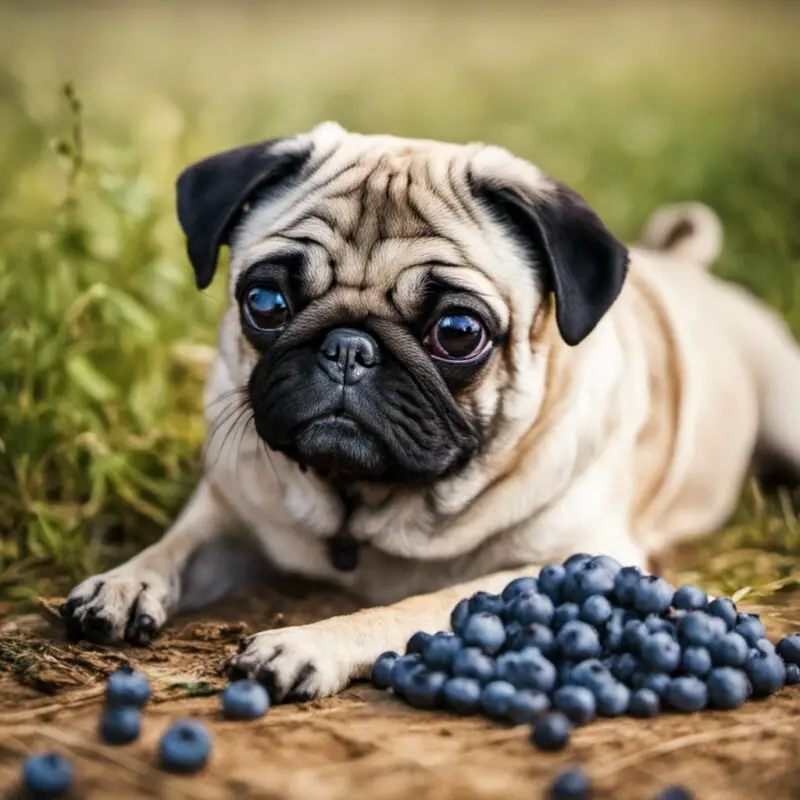
When considering treats for your pug, it’s important to know which fruits are safe for them to eat. Bananas are a great option for a tasty treat, as they are rich in potassium and vitamins, but should be given in moderation due to their sugar content.
Blueberries are another excellent choice for your pug as they are low in calories and high in antioxidants and vitamins. They can be served fresh or frozen for a refreshing summertime snack. Carrots are not only fruits but also a healthy option for your pug. They provide dietary fiber, vitamins, and potassium, which can help to support their overall health.
Mangoes are safe for pugs to eat and can be an enjoyable treat. Just be sure to remove the skin and seed, as these parts are unsuitable for dogs. Mangoes contain vitamins A, B6, C, and E, which makes them a nutritious snack, but remember to offer them in small quantities as they are high in sugar.
Oranges can also be given to your pug, but only as an occasional treat. They are high in vitamin C and can help to boost your dog’s immune system. However, excessive consumption of oranges can lead to gastrointestinal issues due to their acidic nature. Removing the rind and seeds is crucial, as they can cause blockages in your dog’s digestive system.
Lastly, apples are a popular fruit option for pugs. They are low in calories, high in fiber, and packed with vitamins A and C. Just be sure to remove the apple seeds, as they contain a small amount of cyanide, which can be dangerous if ingested in large quantities.
Remember that providing a balanced diet for your pug is essential, and fruits should only be given as occasional treats. Offer small and manageable portions to ensure your pug’s safety and enjoyment.
Toxic Foods for Pug

When it comes to your pug’s diet, it’s essential to be aware of the toxic foods that can harm them. Here are some of the harmful foods that you should avoid feeding your lovable Pug:
Chocolate is highly toxic to pugs due to the theobromine substance it contains. This can lead to numerous health problems, so avoid giving chocolate to your dog.
Grapes and raisins are harmful to pugs as well. These seemingly harmless fruits can cause kidney failure in dogs, so it’s best to keep them out of your pug’s reach.
Nuts, especially macadamia nuts, pose a serious risk to your pug’s health. They contain toxins that can affect your dog’s nervous system, leading to muscle tremors, weakness, and even paralysis.
Xylitol, a common artificial sweetener found in sugar-free products, is extremely dangerous to dogs. Ingesting even a small amount of xylitol can cause a rapid insulin release, leading to hypoglycemia and potential liver failure.
Lastly, avocados should also be avoided. While the fruit itself might not be toxic, the skin, leaves, and pit contain a toxin called persin, which can cause gastrointestinal issues in dogs.
Note on Feeding Practices
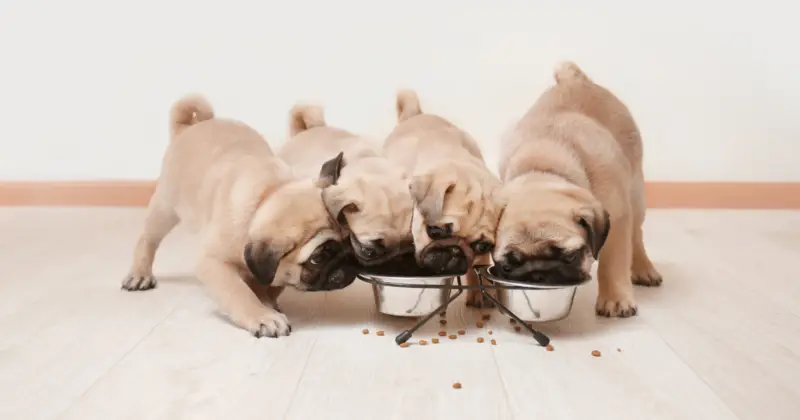
When it comes to your Pug’s diet, it’s important to consider their unique dietary needs and potential food allergies. Always consult your vet before introducing new foods, as they can provide guidance and recommendations tailored to your dog.
In general, giving your Pug small amounts of new foods is best to ensure they don’t experience any adverse reactions. Feeding in moderation is crucial, as overfeeding or providing too much of a certain food item can lead to health problems. Even if ice cream might seem like a harmless treat for humans, it’s essential to understand the potential risks associated with feeding it to your dog.
Some dogs may be lactose intolerant, which means they cannot properly digest lactose found in dairy products like ice cream. In such cases, consuming ice cream can lead to digestive problems, such as bloating, gas, and diarrhea. Furthermore, ice cream is often high in sugar, which could be harmful to your Pug in large quantities.
One way to mitigate such risks is by offering your Pug dog-safe alternatives, like fruit or veggies, that provide nutritional benefits without the potential issues associated with ice cream. Remember to consult your vet when introducing new treats, especially if your dog has a history of food allergies or sensitivities. By following these feeding practices and being mindful of your Pug’s individual needs, you can ensure they maintain a healthy and balanced diet.
Dog Food Vs. Human Food

When it comes to feeding your pug, understanding the differences between dog food and human food is essential. High-quality dog food is specifically designed to meet the nutritional needs of your furry friend. It contains a balanced blend of protein, fiber, vitamins, and minerals to ensure optimal health.
On the other hand, human foods are not always suitable for dogs. While some can be a great source of nutrients, such as meat and eggs, others can be harmful or even toxic to your pug. Educating yourself on which human foods are safe and which should be avoided is crucial.
One key difference between dog food and human food is the protein source. Dogs require a higher percentage of protein in their diet compared to humans. High-quality dog food contains considerable protein, usually derived from various meat sources. Eggs are another excellent addition to your dog’s diet, as they are rich in protein and easily digestible.
On top of protein, dogs also need an appropriate amount of fiber in their diet to maintain proper digestion and weight. Human foods generally contain a different balance of these nutrients, and frequent consumption of human food can disrupt your dog’s digestive system. This is why providing your pug with dog food that supplies the right amount of fiber and keeps their gut healthy is crucial.
When it comes to vitamins and minerals, dogs have different requirements than humans. Some essential vitamins for dogs, like vitamins A and D, can be found in dog food and specific human foods, such as eggs and certain types of fish. However, other human foods, like ice cream, are inappropriate for pugs because they can cause digestive issues or contain harmful ingredients.
In conclusion, while some human foods can be a valuable addition to your pug’s diet, it’s essential to understand the differences between dog food and human food. Providing your pug with high-quality dog food will ensure they receive all the nutrients they need to thrive.
So, Can Pugs Eat Ice Cream?

When it comes to feeding your pug ice cream, the general consensus is to avoid it. While it may be tempting to share a sweet treat with your canine companion, there are several reasons why ice cream is not recommended for dogs.
Firstly, many dogs are lactose intolerant, meaning they lack the digestive enzyme lactase needed to break down lactose, a milk sugar found in dairy products like ice cream (source). Feeding them ice cream can lead to digestive upset, including diarrhea and vomiting.
Additionally, the high-fat content in ice cream can trigger pancreatitis in some dogs, as their digestive systems are not equipped to handle the same foods we eat (source). Pancreatitis can be a serious condition requiring veterinary care.
Furthermore, some ice creams contain xylitol, an artificial sweetener that is toxic to dogs. Xylitol poisoning in dogs can cause vomiting, loss of coordination, seizures, and even liver failure and death (source).
Instead of ice cream, consider providing your pug with dog-safe treats and chews such as rawhide, actual beef bones, and pig ear chews (source). These options are specifically designed for dogs, ensuring that they receive adequate nutritional value while satisfying their natural urge to chew.
So, while it’s natural to want to spoil your pug with tasty treats, it’s best to steer clear of ice cream and opt for safe and healthy alternatives for your furry friend.
Frequently Asked Questions
Is vanilla ice cream harmful to pugs?
While a small lick of vanilla ice cream might not cause immediate harm to your pug, it is generally not recommended to feed them ice cream. Dogs’ digestive systems are not equipped to handle the high levels of fat and sugar found in ice cream, which may lead to stomach upset or more serious issues in some cases source.
What are the effects of ice cream on a dog’s health?
Feeding your pug ice cream can cause gas, bloating, constipation, diarrhea, or vomiting, as their digestive system struggles to process the lactose and sugar content source. In more severe cases, the high fat content in ice cream can trigger pancreatitis, impacting your dog’s overall health and well-being.
How to treat a pug with diarrhea after eating ice cream?
If your pug experiences diarrhea after consuming ice cream, it’s best to consult your veterinarian for advice. They may recommend withholding food for 12 to 24 hours, followed by a bland diet, or prescribe medications depending on the severity of the symptoms. Always monitor your pug closely and ensure they have access to fresh water during this time.
Where can I purchase ice cream made for dogs?
There are dog-friendly ice cream alternatives available which are specifically formulated for canine consumption. These can be found at many pet supply stores or online retailers. Look for products made with dog-safe ingredients and free from added sugars or artificial sweeteners source.
Can pugs safely consume whipped cream?
Whipped cream, like ice cream, contains dairy and sugar which can cause digestive issues in pugs. It’s best to avoid feeding your pug whipped cream and opt for healthier, dog-friendly treats instead.
Can pugs eat ice without any issues?
Plain ice without any added flavors or sweeteners is generally safe for pugs to consume in moderation. Chewing on ice cubes can help cool your pug during hot weather and can also be a fun treat for them. However, be cautious with the size of ice cubes to prevent choking, and avoid feeding too much ice as it might lead to teeth damage or cause discomfort in sensitive dogs.


